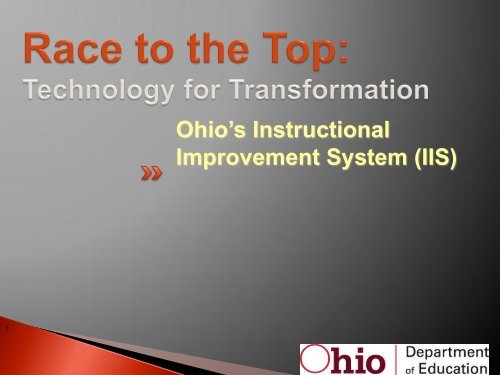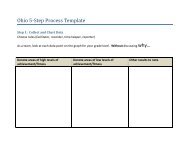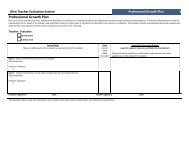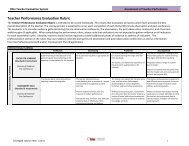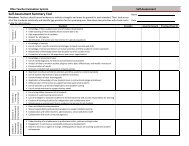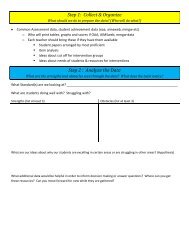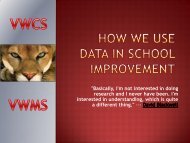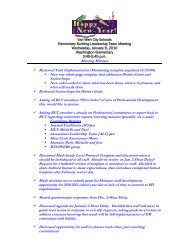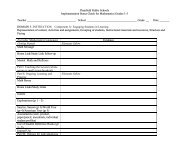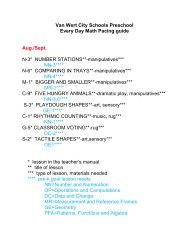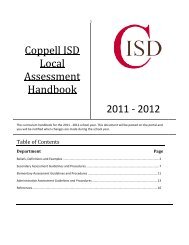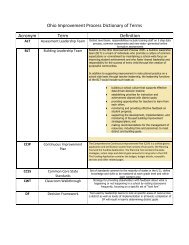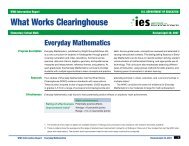IIS Overview
IIS Overview
IIS Overview
You also want an ePaper? Increase the reach of your titles
YUMPU automatically turns print PDFs into web optimized ePapers that Google loves.
1<br />
Ohio’s Instructional<br />
Improvement System (<strong>IIS</strong>)
Better standards.<br />
Better teaching.<br />
Better schools.<br />
Data-driven results.<br />
That's what we will reward with<br />
our Race to the Top Fund.<br />
~President Barack Obama, July 24, 2009<br />
2
A. State Success Factors<br />
B. Standards and Assessments<br />
C. Data Systems to Support Instruction<br />
D. Great Teachers and Leaders<br />
E. Turning Around the Lowest-achieving<br />
3<br />
Schools
DATA SYSTEMS<br />
• Designed to support instruction<br />
• Fully implementing a statewide<br />
longitudinal data system<br />
• Accessing and using state data<br />
• Why<br />
4
I am a deep believer in the power of data<br />
to drive our decisions.<br />
Data gives us the roadmap to reform.<br />
It tells us where we are,<br />
where we need to go,<br />
and who is most at risk.<br />
5<br />
~Secretary of Education, Arne Duncan,<br />
Fourth Annual IES Research Conference
1. Expand Value Added Statewide<br />
2. Improve Access to Student Data<br />
3. Personalize Learning through<br />
Formative Instruction<br />
6
Students<br />
Can track their progress and show when<br />
their efforts all pay off.<br />
Teachers<br />
Can make informed decisions about their<br />
instruction and in the design of effective<br />
interventions.<br />
Principals<br />
Can engage with teachers about student<br />
growth and make meaningful decisions<br />
about staffing, resource allocations,<br />
programs, and services.<br />
7
Parents<br />
Will have a more informed<br />
sense of their child’s progress .<br />
District<br />
Leaders<br />
Can communicate effectively to the<br />
public, design a budget with student learning<br />
driving resource allocation, and engage with<br />
principals about accountability.<br />
Community<br />
Will have a better accountability system<br />
that aligns student growth with<br />
community investment.<br />
8
9<br />
The <strong>IIS</strong> is a suite of technological tools that provide<br />
teachers, principals, and administrators with<br />
meaningful support for a cycle of continuous<br />
instructional improvement, including activities such<br />
as instructional planning; gathering information;<br />
interim assessments; analyzing information with the<br />
support of rapid-time reporting; using this<br />
information to inform decisions on appropriate next<br />
steps, and evaluating the effectiveness of the actions<br />
taken .
10<br />
Structure and Components:<br />
◦ Online access to electronic curriculum,<br />
resources and tools aligned to the revised<br />
standards<br />
◦ Curriculum customization for differentiated<br />
instruction<br />
◦ Online formative assessments<br />
◦ Data-analysis capabilities including earlywarning<br />
indicators for teachers,<br />
administrators, parents, and students.
ODE commits to provide a<br />
State <strong>IIS</strong> to all participating RttT<br />
LEAs in Ohio. Development<br />
will be completed with LEA<br />
input. The system will be paid<br />
for by ODE during RttT.<br />
11
RttT LEAs commit to active<br />
use of a “qualifying” <strong>IIS</strong> in<br />
classrooms.<br />
◦State <strong>IIS</strong> OR<br />
◦“Qualifying” LEA <strong>IIS</strong><br />
12
Background<br />
- 2 States (Ohio / Florida)<br />
- Center for Educational Leadership<br />
and Technology (CELT)<br />
- Define <strong>IIS</strong> Requirements<br />
13
CELT<br />
- Statewide Brainstorming Meetings<br />
- Focus Groups<br />
- Cross-state Meetings<br />
- Requirements Development<br />
14
Standards /<br />
Curriculum<br />
(What)<br />
Assessment<br />
and Growth<br />
(How Well)<br />
Learners<br />
(Who)<br />
Instructional<br />
Practices<br />
(How)<br />
Educators<br />
(By Whom)<br />
15
Standards/Curriculum<br />
Curriculum Design<br />
& Development<br />
Curriculum<br />
Evaluation<br />
Curriculum<br />
Maintenance<br />
Data Analysis<br />
& Rapid-Time<br />
Reporting<br />
Advanced<br />
Analysis<br />
(current &<br />
historical)<br />
Instructional<br />
Design<br />
Instructional<br />
Practices<br />
16<br />
Achievement<br />
Reporting<br />
Achievement<br />
Analysis<br />
Test Scoring<br />
& Processing<br />
Educator Profiles &<br />
Professional Development<br />
Test Delivery<br />
& Response<br />
Test Creation &<br />
Storage<br />
Assessment<br />
Tools<br />
Class Data<br />
Management<br />
Tools for<br />
Learning<br />
Assessments & Growth
1 – Standards and Curriculum<br />
2 – Instructional Practices<br />
3 – Assessment and Growth<br />
4 – Data Analysis and Reporting<br />
17
5 – Student Portfolios<br />
6 – Educator Profiles<br />
7 – Data and System Integration<br />
8 – IT Platform, Access & Security<br />
18<br />
9 – Documentation, Training &<br />
Support
Results of CELT work<br />
December, 2010<br />
COMPLETED<br />
• Hold LEA Meetings to<br />
document requirements<br />
• Develop RFP<br />
Issue RFP<br />
December, 2011<br />
Award Contract<br />
March, 2012<br />
Integration of Pilot<br />
LEAs<br />
December, 2012<br />
Statewide<br />
Rollout<br />
Complete!<br />
March, 2014<br />
Statewide<br />
Rollout<br />
19<br />
2010 2011 2012 2013 2014


